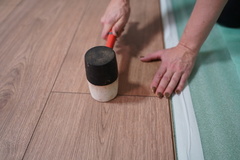Concrete is composed of water, cement and fine aggregates. Its properties depend on the properties of its components. One of the basic parameters that determine the strength of a concrete floor is the concrete creep. It depends on certain admixtures and, above all, on the water-to-cement ratio. The smaller the water-to-cement ratio, the higher the quality of concrete.
Before installing a concrete floor, estimate the state of the base. It is very important to find out if he base has been waterproofed. If there is an old concrete base, carefully review its technical documentation. If there is none available, a survey should be carried out to make your work planning more efficient.
Later:
- Preparation for concreting. If there is an old base, remove all its loose parts. Wash it carefully to get rid of the dirt, dust and grease.
- Waterproofing. Insert a watertight polymer between the existing base and the newly applied concrete. It will ensure a better sliding of the slab between the movement joints. Otherwise, cracks may appear between the joints.
- Reinforcement. If the base is sufficiently strong, apply a double layer of steel reinforcement mesh. Its task is to take up the strain caused by the contraction of the cured concrete.
- Concrete admixtures. To prevent fresh concrete from cracking, polymer or metal fiber are typically added into concrete during the manufacturing process. Besides, certain shrinkage reducing admixtures, called plasticizers, are added. The remaining part is added right before laying the concrete, because plasticizers stay effective within 30-50 minutes after they are included in the mixture. Plasticizers are applied after considering the service requirements and the temperature.
- When concrete has been delivered, a contractor should already have a floor plan completed. If a thick coating, such as magnesia concrete or polymer coating with quartz aggregate is to be placed, it is enough to consolidate concrete with a concrete vibrator and level it with a screed vibrator. However, if a thin polymer coating is going to be applied, or the concrete slab is going to be painted, it is necessary to level the floor by special levelling machines. Otherwise the thin coating applied will reflect the roughness of the slab.
- Dust-proofing of the surface is ensured through adding certain mineral aggregates. They are applied on the levelled and freshly poured concrete. Not only do they enhance drying of the concrete, they also chemically adhere substances that cause dust, making the floor denser, more durable and easier to clean.
- Control joints. When installing a concrete floor, do not forget about the control joints. They allow concrete slab to contract and expand without cracking caused by internal stresses. Joints should be cut from 30 mm to ½ of the depth of the slab, depending on the thickness of the slab, as well as on the method of installation. Then seal the cuts with special sealers.
Buildings are subject to various stresses. The part which is bears most load is the floor. When placing a concrete floor, keep in mind that the composition of concrete affects its durability, abrasion resistance, density, as well as its resistance to cold, shrinkage and water.
Even though concrete is generally capable of bearing increased loads, sometimes extra-sturdy concrete surface is needed. In that case, the dry-shake application method is used, involving covering of a concrete slab with a hardener, providing additional abrasion and dust resistance to the concrete.
The dry-shake application method is a fairly simple procedure. A special hardening mixture is trowelled into the surface of the freshly laid and levelled concrete. The hardener improves the technical properties of concrete, such as pressure, impact and abrasion resistance, makes it dust-proof, as well as improves the general appearance of the floor.
Dry-shake hardeners
Dry-shake hardeners are typically composed of dry cement and fine aggregates. The mixture is trowelled into the freshly levelled concrete surface. The blend can either contain or lack pigments.
When trowelled into the concrete, the hardener penetrates into the surface of the slab, providing additional density to it. After the final grinding, most pores on the concrete close, making concrete especially resistant to cold. Such floors can have a lifespan of around 15-20 years. Because both the slab and the hardener contain Portland cement, the hardened surface adheres to the slab so that both of them make a whole. The surface compression strength can be higher than 90 mPa. Up-to-date concrete floors made with applying dry-shake hardeners can withstand very significant loads.
Advantages of the floor with dry-shake topping
Durability
Dust resistance
Abrasion resistance
Easy maintenance
Fast technological process
Colours can be applied
The hardener adheres to the slab, making a whole with it
Places where dry-shake topping can be applied:
1. Workshops, warehouses
2. Commercial premises
3. Garages for passenger cars and trucks
4. Parking lots
Properties:
- concrete can be walked on after 24 hours
- the floor is able to bear light loads in a week
- major loads are allowed after 12-28 days after application

